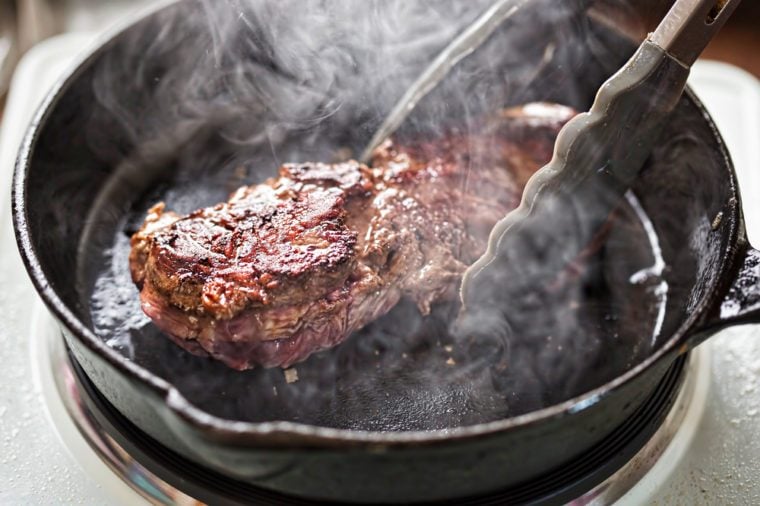Seasoning can make or break a dish.
Food Network
Too much and it's overwhelming, too little and it's completely tasteless. But when you get just the right amount? Your final product can be next-level. Here are 12 practical tips and tricks that can help you become a seasoning pro.
1. Learn the difference between salt varieties and when to use them.
All salts are not created equal. Kosher salt (the most popular variety) has crystals that dissolve quickly. This is a great go-to salt for just about everything. Table salt, on the other hand, is much finer and a little goes a long way. This is best for keeping on the table so people can add it on top of foods. If you're using table salt in place of kosher when cooking, make sure to use less and taste as you go. Coarse salt (the largest of the three) is best for finishing with. It's not great for baking as the crystals are too large to dissolve.
2. And know when to use finely ground pepper versus cracked varieties.
Karimitsu / Getty Images, Ekaterina_lin / Getty Images
How you grind your pepper (or how you buy it ground) can completely change the flavor it imparts. Finely ground pepper (the kind that looks like dust) is best used for things like sauces. It's pretty strong and a little goes a long way. Coarse ground pepper, on the other hand, is best for finishing dishes at the table with or seasoning proteins. The flavor is usually less sharp and it doesn't infuse into the entire dish. For most things, coarse ground pepper should be your go-to.
More: .
3. Season from high above for more even coverage.
Besides looking cool, there's actually a reason why chefs season their food from so high up. It helps evenly distribute the seasoning and makes sure you don't accidentally over-season one area and under-season another. This is especially helpful for items like steak that benefit from an even layer of seasoning.
More: .
4. Toast your spices to bring out their flavors...
Toasting whole spices before grinding them takes their flavor to a whole new level, adding complexity and aroma to a dish. To do so, just place them into a pan over medium-low heat and toast, swirling often, until fragrant. As soon as you start to smell them, remove them from the pan to make sure they don't burn.
More: .
5. And use a coffee grinder to grind whole spices for a stronger flavor.
Instead of buying a fancy spice grinder or mortal and pestle, just use a coffee grinder to grind your spices. After using, you can grind up some uncooked white rice to clean it out and get rid of the flavor (so your coffee doesn't taste like cloves).
6. Remember that cold foods require a bit more seasoning than hot foods.
Many people think that you're able to taste hot foods better than cold, and therefore have to make up for it by adding extra seasoning to cold dishes. A good example (and one that's often overlooked) is salad. Along with dressing, adding a pinch of salt can help make the flavors shine and your salads taste better.
7. Don't forget to season certain foods with sugar, too.
Michellepatrickphotographyllc / Getty Images
Making a good marinara with bad tomatoes is not easy — but if you add a pinch of sugar, the sauce will taste like it was made with perfectly ripe ones. Sugar enhances the flavors of savory foods, such as roasted carrots, beets, and tomatoes, and plays an important role in balancing flavors. Just like salt, it can help food come to life.
8. Remember to add dry herbs in the beginning of your cooking, and fresh at the end.
Burwellphotography / Getty Images
Dried herbs are best used during cooking — either stewed in a sauce, simmered in a stew, or braised with meat. This gives them time to infuse their flavor into a dish and come back to life. Fresh herbs, on the other hand, are already bursting with flavor and best used without much cooking. Fresh basil, for example, is best used as is — simply tossed in pasta or thrown into a salad.
More: .
9. Pre-season your proteins ahead of time so the salt has time to penetrate and flavor the meat.
There's several reasons why you should be seasoning your proteins a few hours in advance. First, it gives the salt enough time to penetrate the meat and season it in the center. The salt also breaks down some of the proteins that can make meat tough — and it actually helps the meat stay moist via reverse osmosis. It's a true win-win!
10. Don't be afraid of using flavor enhancers like nutritional yeast, liquid aminos, and even.
Seasoning isn't just about salt and spices. Ingredients such as nutritional yeast can transform the flavor of a dish and add savory notes. Similarly, liquid aminos can add a pop of umami flavor without the sodium content of soy sauce. .

Comments